Birmingham Roller Pigeon Breed Guide
The Birmingham roller pigeon is a domesticated bird and is highly popular because of its incredible aerial performance. While flying, the bird flips in the air and plummets down.
What may seem alarming to some people is that these are incredible and deliberate acrobatics performing pigeons.
It’s clear that exhibition is one of the main reasons why fanciers breed this pigeon. But how do they do it?
In this article, we will talk all about the Birmingham roller pigeon, including tips to breed them successfully.
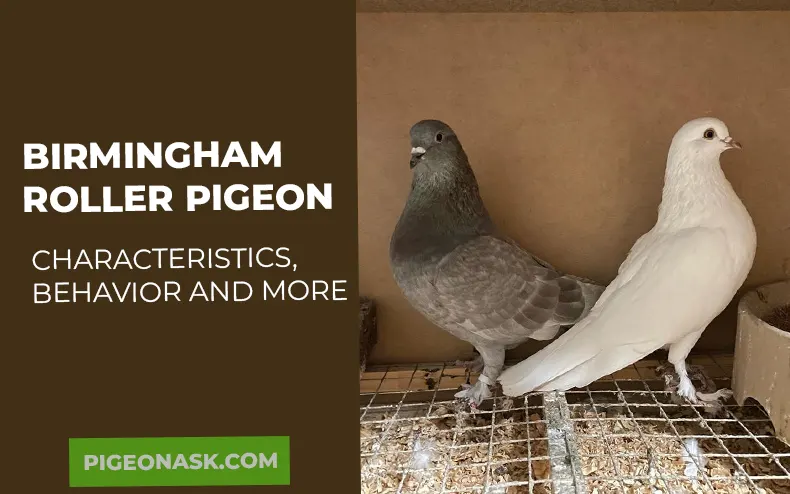
Are you ready? Then let’s start!
Birmingham Roller Pigeon Profile
| Name | Birmingham Roller Pigeon |
|---|---|
| Scientific Name | Columbia Livia |
| Common Names | Birmingham Roller |
| Origin | Birmingham, United Kingdom |
| Size | Small |
| Weight | 350 grams (0.7 pounds) |
| Lifespan | Up to 20 years |
| Temperament | Docile |
| Behavior | Friendly |
| Special Features | Aerial performance |
| Breeding and Maintenance | Easy |
| Common or Popular Varieties | Different colors |
Interested in similar topics on pigeon breed:
Overview of Birmingham Roller Pigeons
The Birmingham Roller pigeon is a domestic and fancy bird first developed in Birmingham, England. Breeders used selective breeding to create this breed, which they raised as a flying bird.
Nowadays, pigeon fanciers breed the Birmingham Roller for show and exhibition because of its ability to perform backwards somersaults midair.
History And Origins of Birmingham Roller Pigeons
The origin of the Birmingham Roller pigeon dates back to hundreds of years ago, with an estimated date set in 1879.
During that time, flying tumblers were a popular breed of bird in the United Kingdom, especially in the “West Midland” counties located in Staffordshire and Worcestershire.
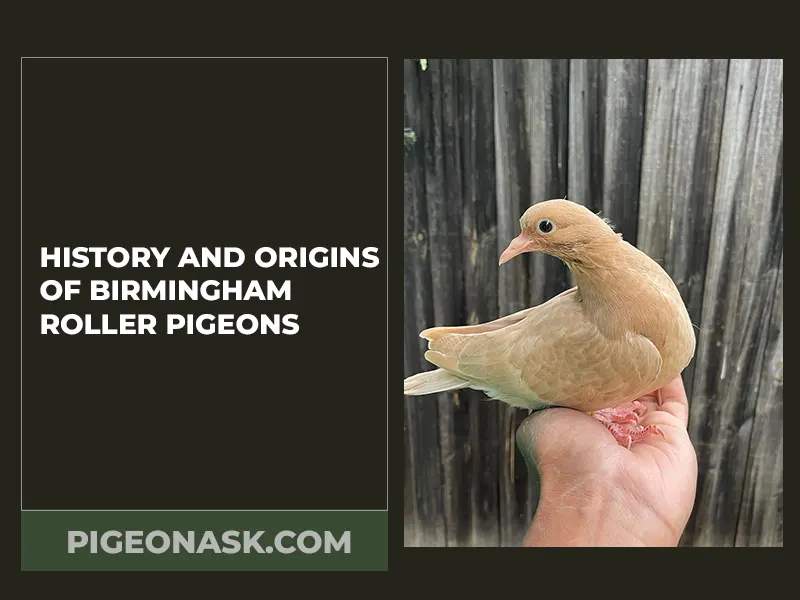
It’s worth pointing out that the breeders did not use the word “Roller” to describe a pigeon breed at the time. Instead, they use this term to highlight the ability of pigeons to perform aerial tricks.
As a result, pigeons capable of performing aerial acrobatics received the name “Flying Tumblers.”
The exact date and origin of the Birmingham Roller is not clear. However, it’s a common belief that breeders developed this breed after noticing pigeons rolling while flying.
Afterward, they bred these birds with others to reinforce this genetic behavior.
Over the years and after the perfection of the Birmingham Roller, pigeon fanciers managed to develop two different types of this breed.
We have the ‘Flying type‘ and the ‘Show type‘ of Birmingham rollers. The Show Rollers are larger and suitable for show purposes, whereas the Flying Roller is more suited for aerial performance because of its tricks.
Fast forward, the Birmingham Roller arrived in the United States in 1932, when a Catholic priest imported it from popular English fancier and author William H. Pensom.
Why Do People Breed the Birmingham Roller Pigeon?
Fanciers developed this pigeon breed via selective breeding. The reason the Birmingham roller pigeon was created is because of its ability to perform fast, backward somersaults while flying, which the pigeons do gracefully.
Why the Birmingham roller pigeon tumbles in flight is also unknown.
However, this breed is not the only one that does it. Show rollers, Parlor rollers and Oriental rollers are similar breeds developed because of their aerial performances.
Physical Characteristics And Features
The Birmingham roller is a beautiful pigeon, but fanciers don’t breed it because of its look.
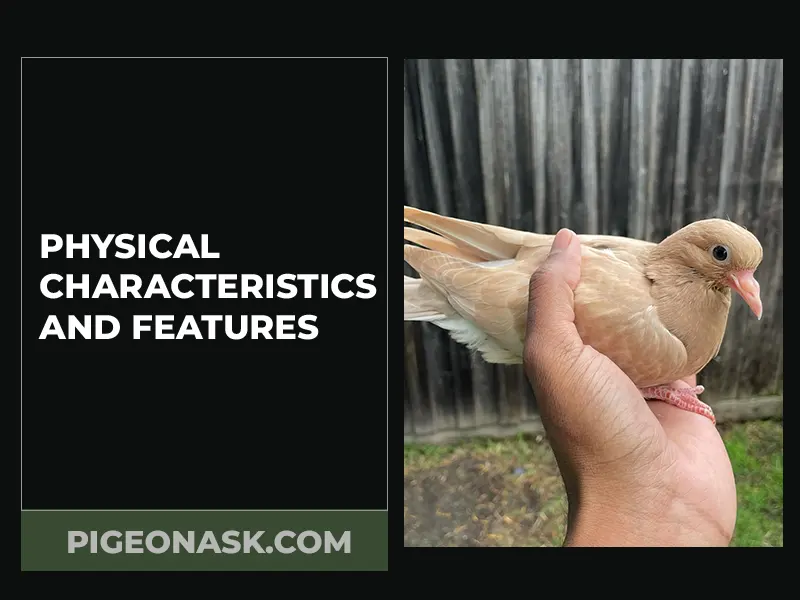
Either way, knowing the physical features of this bird can help you identify to ensure you get a healthy mating pair.
| Name | Birmingham Roller Pigeon Physical Features |
|---|---|
| Head | The head of this pigeon is small, with an oval-like shape. Some variations have a slight flat line over the top of the skull. |
| Eyes | The eyes are black, with small pupils. |
| Beak and Cere | The beak is slightly brown with a pinkish shade and the cere is a lighter color. |
| Neck | The neck is long and wide, very thick compared to the head. |
| Weight | Approximately 350 grams. Weight can vary depending on factors like location and diet. |
| Wings | The wings are long and full of feathers, which can vary in color. |
| Tail | Like the wings, the tail is long and can be of different colors. |
| Legs | Short, pink legs. |
Unique Features
The Birmingham Roller doesn’t have any unique feature other than its origin, a breed developed in Birmingham, England.
Some Common Variations
You can breed this pigeon in most colors. The Birmingham roller can be black, blue, silver, red, almond, white, yellow and dun.
Likewise, the patterns are also common in other pigeon breeds. For instance, this breed can have rosewing, whiteside, badge, bell neck and other patterns.
Distribution And Habitat
Don’t know where to find Birmingham rollers? Check out this section to learn more about the distribution of this bird.
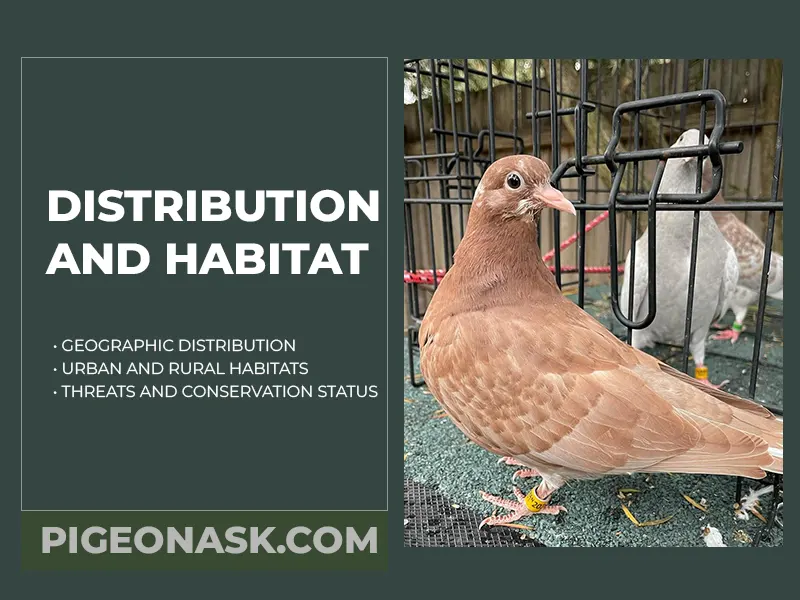
Geographic Distribution
Breeders raise the Birmingham Roller in many parts of the world, including the United Kingdom, North America, Europe, Australia, and South Africa.
These are the most common regions to find this pigeon breed and where fanciers actively breed them for aerial performance.
Urban and Rural Habitats
The preferred environment for this pigeon breed used to be rural or underdeveloped neighborhoods in Birmingham.
This tradition continues to this day, as rural areas are the most suitable for this breed because of their showmanship.
Threats and Conservation Status
The Birmingham Roller Pigeon is a domesticated beauty that doesn’t fall under the umbrella of species needing conservation.
See, when it comes to conservation efforts, the spotlight shines on our wild pigeon pals facing extinction risks.
It’s the wild ones dealing with habitat loss, hunting pressures, and a heap of other human-made threats that need our urgent attention.
But the Birmingham Rollers?
They’re snug as bugs in a rug, safe and sound in our domestic haven.
Behavior And Traits of Birmingham Roller Pigeons
Birmingham roller pigeons are docile and friendly birds. They can be around other pigeons calmly and you can also grab them without complications.
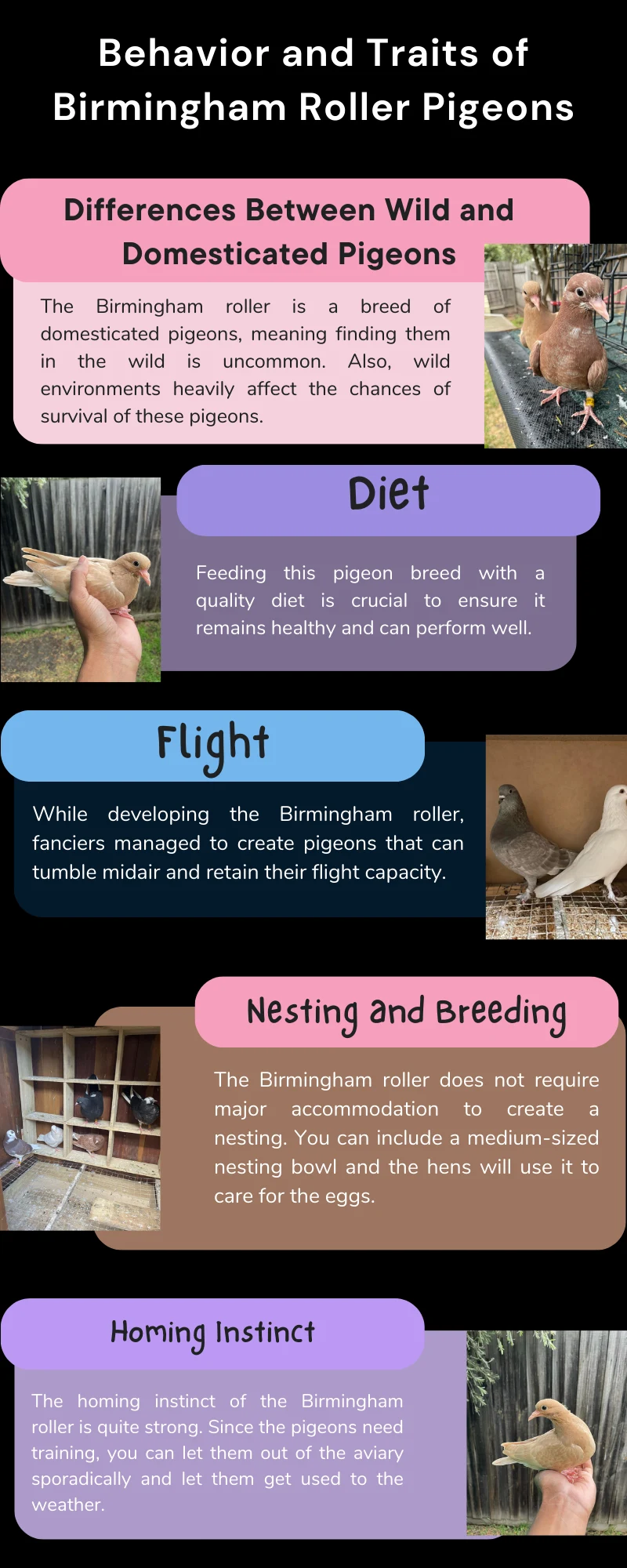
This is helpful, especially when you need to band their legs or take them out to feed them.
Differences Between Wild and Domesticated Pigeons
The Birmingham roller is a breed of domesticated pigeons, meaning finding them in the wild is uncommon. Also, wild environments heavily affect the chances of survival of these pigeons.
They don’t have quality food and face more challenges like predators, among other things.
Diet
Feeding this pigeon breed with a quality diet is crucial to ensure it remains healthy and can perform well.
Ideally, you can provide Birmingham rollers with a balanced diet of commercial bird feed to ensure they get all the nutrients they need. Other than that, you can include treats like seeds and insects.
We also like to feed our rollers with wheat, corn and vegetables. Lastly, a bowl filled with water is necessary to keep them hydrated and clean.
Flight
Before talking about the flight ability of the Birmingham roller, we need to look back in history a little bit.
Traditionally, pigeons with the skill to tumble or roll in the air (tumblers) struggle and lose their flying ability after some time.
While developing the Birmingham roller, fanciers managed to create pigeons that can tumble midair and retain their flight capacity.
As a result, this pigeon breed is among the most efficient in terms of exhibition and sustainability long-term.
Nesting and Breeding
The Birmingham roller does not require major accommodation to create a nesting. You can include a medium-sized nesting bowl and the hens will use it to care for the eggs.
Furthermore, adding small branches could be helpful too, but not necessary.
During mating season, the male and female Birmingham roller can be in a single space to reproduce. After, the male can remain with the female without problem.
Homing Instinct
The homing instinct of the Birmingham roller is quite strong. Since the pigeons need training, you can let them out of the aviary sporadically and let them get used to the weather.
After some time flying around the perimeter, the group (called kit) will return to their resting place.
Breeding And Maintenance
Raising and caring for Birmingham rollers is not a challenging task. The parents do most of the work and you only need to provide a nest and food.

In any case, there are a few considerations you should keep in mind.
Some Tips and Considerations for Successful Breeding
- Select the mating pair by their color and physical features if you’re looking for a specific variation.
- Separate the mating pair from the rest by putting them in a single space in the pigeon kit box.
- After breeding, put bands around the legs of the mating pair to identify them and their offspring.
- Avoid inbreeding if possible. Fanciers breed related pigeons sometimes to evaluate their performance, but the results are not always good and can lead to health problems.
Feeding and Housing Requirements
The most suitable housing for the Birmingham rollers is a pigeon kit box. This is because the box allows you to separate the younglings from the older pigeons, which is very convenient for teaching purposes.
By separating them, you can let the older rollers fly with the younger ones watching and learning.
A pigeon kit box is also helpful because you can keep the younger birds separated and feed them more food.
Over time, the younglings will watch and follow what the older ones do, including how to get inside the box, how to fly, how to land and more.
Feeding
Feed your Birmingham rollers by putting a metal tray with the pellet or other food inside the pigeon kit box.
You can take this opportunity to teach the pigeons, encouraging them to get inside the kit box with food as an incentive.
Final Word
The Birmingham roller is not the fanciest pigeon, but its incredible aerial performance can captivate anyone.
We loved this pigeon for its acrobatic display and we loved it even more because of how easy it is to breed and raise them.
So, if you’re a fancier looking for a fun and interesting pigeon to breed, the Birmingham roller is a suitable option.
Did you fall in love with this pigeon breed?
Keep in touch with us by following our social media on Facebook, Twitter, and Pinterest. We constantly write insightful articles about pigeons and other fascinating birds.
